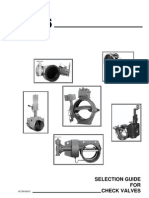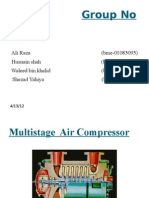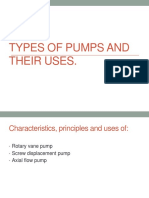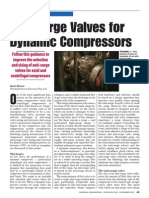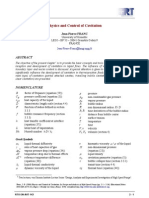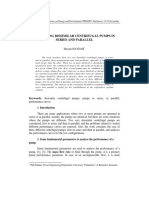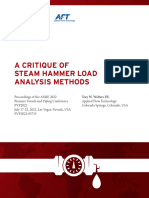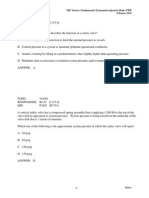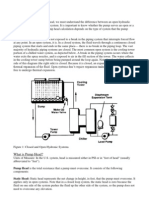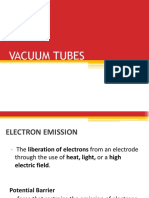Understand The Basics of Centrifugal Pump Operation: Fluids/Solids Handling
Understand The Basics of Centrifugal Pump Operation: Fluids/Solids Handling
Uploaded by
Việt Đặng XuânCopyright:
Available Formats
Understand The Basics of Centrifugal Pump Operation: Fluids/Solids Handling
Understand The Basics of Centrifugal Pump Operation: Fluids/Solids Handling
Uploaded by
Việt Đặng XuânOriginal Title
Copyright
Available Formats
Share this document
Did you find this document useful?
Is this content inappropriate?
Copyright:
Available Formats
Understand The Basics of Centrifugal Pump Operation: Fluids/Solids Handling
Understand The Basics of Centrifugal Pump Operation: Fluids/Solids Handling
Uploaded by
Việt Đặng XuânCopyright:
Available Formats
Fluids/Solids Handling
Understand the Basics
of Centrifugal Pump
Operation
Kimberly Fernandez,
By starting from such fundamentals
Bernadette Pyzdrowski, as head and pressure, the authors have
Drew W. Schiller and
Michael B. Smith,
developed practical tips for specification
KBR and operation that provide for
cost-effectiveness and reliability.
C entrifugal pumps are the most com-
mon type of kinetic pump, and are
used most often in applications with
moderate-to-high flow and low head.
As the workhorse of the chemical process industries
(CPI), centrifugals are almost always more econom-
ical to own, operate and maintain than other types
During specification, the maximum pressure a pump
will develop during any aspect of operation, including
startup, shutdown and upset conditions is determined.
The shutoff pressure is the maximum pressure a pump
will develop under zero-flow conditions, which reflects a
fully blocked outlet. Variables to consider when deter-
mining the design pressure include:
of pumps. • maximum pressure of the source (e.g., relieving
pressure of a vessel)
Parameters needed in specifying • maximum head developed by the pump (i.e., shut-
The process engineer is normally responsible for off head)
specifying the process requirements of the pump, includ- • maximum static head of the fluid in the pump’s
ing the conditions and physical properties of the liquid, suction line
and, most importantly, the flowrate, pressure, density • maximum pump operating speed (for variable-
and viscosity. The flowrate determines the capacity of speed drives)
the pump, and the head depends on the density and vis- • possibility of operator intervention during an upset.
cosity of the liquid. The head h is the most commonly used measurement
In general, the required flowrate is determined by the of the energy at any point of the system, or of the system
material and energy balances. Design margins, typically as a whole. It is defined as:
between 0–25%, are added to the material-balance
flowrate to account for unexpected variations in proper- v 2 2.31P
ties or conditions, or to ensure that the overall plant h= + +z (1)
2g Sg
meets its performance criteria. Also, minimum flow pro-
tection is often added as continuous circulation. Occa- where v = the velocity of the fluid (ft/s); g = acceleration
sionally, the required flowrate (including design mar- of gravity (32.2 ft/s2); P = pressure (psia); Sg = specific
gins) may fall in the low range of that for centrifugal gravity; and z = elevation above (+) or below (–) the
pumps. In such cases, a minimum-size pump rated for pump (ft).
continuous service is specified, and the extra pump ca- The energy that the pump imparts to the liquid, the
pacity is typically consumed by circulation from the dis- total dynamic head, TDH, takes into account differences
charge to the source. in pressure, liquid elevation and velocity between the
52 www.cepmagazine.org May 2002 CEP
■ Figure 1. Understanding a simplified pump
hydraulic-circuit schematic aids in selection.
Pump Source Pump Destination
source and destination. In addition, TDH accounts for line
(friction) losses and the pressure drop through the instrumen-
Suction
tation and other items in the flow path of the liquid: Pipe Discharge
Pipe
144 × [ P2 − P1 + ∆Pf + ∆Pother ]
TDH =
ρ
Centrifugal Pump
[V22 − V12 ]
+ + [ Z2 − Z1 ] (2)
2g
Ensuring adequate available NPSH
where P = pressure (psia); ∆Pf = frictional loss through pip- Pump suppliers set the NPSH required (NPSHR) for a
ing (psi); ∆Pother = pressure loss through instrumentation and given pump. The NPSHR takes into account any potential
flow-restriction orifices (psi); Z = elevation (ft); V = velocity head losses that might occur between the pump’s suction
(ft/s); and ρ = density (lb/ft3). The subscripts 1 and 2 refer to nozzle and impeller, thus ensuring that the fluid does not drop
source and destination, respectively. Figure 1 shows a typi- below its vapor pressure. NPSHA must exceed the NPSHR
cal setup that can be described by using Eq. 2. set by the supplier.
There is an advantage to measuring the energy of a pump There are a few options available to increase NPSHA,
as head, rather than pressure. The head applies to any liquid should it be at or below the NPSHR. Increasing the source
that is pumped at the same rated capacity and speed, as long pressure or reducing the fluid vapor pressure (by cooling) are
as the viscosity is low (generally, less than 10 cP). The head rarely feasible. Therefore, there are two process variables re-
produced by a pump will remain constant (at a given flowrate maining that can be adjusted — the static head and friction
and speed), even though the pressure differential and power losses (see Eq. 3).
requirements vary. Static head can be raised by three methods:
Eqs. 1 and 2 show that fluid properties have a significant 1. Raise the elevation of the source point. This may prove
impact on the head. In particular, as density and viscosity in- impossible in some cases (e.g., a tank that is set at grade).
crease, so will the amount of work needed to drive the pump. 2. Lower the elevation of the pump inlet. This is a less ap-
This is why the process engineer must specify not only the pealing option because pumps are typically located just
normal values for density and viscosity, but also the maxi- above ground level, and lowering the inlet may require the
mum values that the pump is likely to encounter during ex- suction nozzle to be below grade. This usually results in a
treme situations, such as startup, shutdown or process upsets. much more expensive pump.
Also, the engineer must determine the maximum operating 3. Raise the level of fluid in the suction vessel. The ac-
temperature, and whether the fluid may contain suspended ceptability of this approach varies from company to com-
solids or dissolved gases. pany and should not be used without first consulting com-
Further, the pump must be specified to avoid cavita- pany procedures.
tion. Cavitation occurs when the suction pressure of the Friction losses can be reduced either by increasing the di-
pumped fluid drops below its vapor pressure, leading to ameter of the pump suction-piping and/or reducing the equiv-
the formation of vapor bubbles. As the fluid becomes alent length of the suction line. In a grassroots plant, friction
pressurized again in the pump, these bubbles implode, losses should already be minimal, so raising static head is
leading to pitting of the impeller and other pump compo- more viable. Reducing friction loss is usually more appealing
nents. In addition, since vapor has a lower density than for suction lines in existing plants where throughput has been
liquid, cavitation leads to a reduction in the pump capaci- increased above the original nameplate capacity.
ty and efficiency. There are also a few options to reduce the NPSHR of the
The net positive suction head (NPSH) is a measure of the pump, which include using a larger, slower-speed pump, a
proximity of a liquid to its bubble point (or vapor pressure). double-suction impeller, a larger impeller inlet (eye) area, an
The available NPSH (NPSHA, ft) is given by: oversized pump and an inducer, which is a secondary im-
peller placed ahead of the primary impeller.
NPSHA =
[P − P
1 vp ]
− ∆Pf × 144
+ [ Z1 − Zinlet ] (3)
Running in series or parallel
ρ Centrifugal pumps operate within ranges of head and ve-
locity. Operating outside of these ranges may require using a
where: Pvp = vapor pressure of the pumped fluid (psia) and Zinlet specialty pump. Other options for handling high-head or
= centerline elevation of the pump suction nozzle (ft). The other high-flow applications include using pumps in series or paral-
variables in Eq. 3 have the same meaning and units as in Eq. 2. lel. When running in series, the heads are added, and the total
CEP May 2002 www.cepmagazine.org 53
Fluids/Solids Handling
capacity is equal to that of the pump with the smallest capac- tional centrifugal pump specifications that must be met, as
ity. In parallel, the capacities of the pumps are added, and the well.
head of all pumps will be equal at the point where the dis- Every pump has a specific curve that relates head, flow,
charged liquids recombine. Parallel pumps are used for a va- power, NPSHR and efficiency for specific impeller diameters
riety of reasons, including cost (two smaller pumps may cost for that particular unit (Figure 3 (2)). This enables correct se-
less than a larger one), an increase in the size of an existing lection of the impeller diameter. During specification, the
plant, or to compensate for a process with varying capacity. goal is to select a pump with a rated (or design) point as close
Note that pumps operated in parallel must have similar head as possible to the best efficiency point (BEP), as determined
characteristics to avoid potential operating problems. by the pump manufacturer.
Often, process engineers need to estimate the horsepower
requirement of a pump during the early design stages of a Selection rules-of-thumb
project, before a selection is made. Brake horsepower (BHP) The general guidelines for proper selection are:
is related to the flowrate Q (gpm), total dynamic head TDH • Select the pump based on rated conditions.
(ft), specific gravity Sg, and efficiency η: • The BEP should be between the rated point and the nor-
mal operating point.
• The head/capacity characteristic-curve should continu-
(TDH )(Q)( Sg)
BHP = ( 4) ously rise as flow is reduced to shutoff (or zero flow).
3, 960 η • The pump should be capable of a head increase at rated
conditions by installing a larger impeller.
The actual efficiency is set by the pump supplier when the • The pump should not be operated below the manufactur-
final pump selection is made. It is normally based on shop er’s minimum continuous flowrate.
tests of previously built pumps of the same model and size. A As can be seen from the pump curve, the pump has a spe-
reasonable estimate can be determined by using a graph cific NPSHR, which varies, depending on the head and flow.
found in a handbook. In general, efficiency varies from a low Once the specific pump model and size have been deter-
of about 10% for a small centrifugal pump, to a high of 80% mined from the basic process information, the materials of
for a large cooling-water type pump. construction must be chosen. Selection depends on fluid
Another item to consider is pump failure. Pumps in criti- properties, such as corrosiveness or erosiveness, and the pres-
cal service that operate continuously should have a standby. ence of dissolved gases. Knowing as much as possible about
Depending upon the criticality of the service, auto-start pro- the chemical composition of the fluid helps to ensure proper
visions may be necessary to start the standby upon sensing a material selection of the pump and its shaft seal.
low discharge pressure. The standby pump can reduce plant
shutdowns and prevent economic losses. Drivers and seals
Referring to Figure 3, the required driver power for the
Tips for specification pump is related to head and flow. The different types of
Assuming that the rated head and flow are known, a pre- drivers include electric motors, internal-combustion engines,
liminary selection can be made for pumps that fall within steam and gas turbines, and hydraulic power-recovery tur-
normal ranges of operation, as shown in Figure 2 (1). This bines. Driver selection depends upon many factors including
preliminary selection exercise gives a good assessment of the type of service, availability of steam or fuel (for turbines),
pump type that fits the required process conditions. The spe- and cost. The most common driver is the electric motor. Mo-
cific pump type will also influence what standard specifica- tors can vary in size depending upon power, speed, frame
tions might be required. Some industry and national specifi- size, area classification, orientation and other considerations.
cations for centrifugal pumps include: Motor specifications should consist of both mechanical and
• ASME/ANSI B73.1, “Specification for Horizontal End electrical requirements, including the area hazard-classifica-
Suction Centrifugal Pumps for Chemical Process,” and tion set by the National Fire Protection Agency (NFPA). A
ASME/ANSI B73.2M, “Specification for Vertical In-Line motor should be sized to meet the maximum specified oper-
Centrifugal Pumps for Chemical Process” (www.asme.org). ating conditions and should be able to meet end-of-curve
• API-610, “Centrifugal Pumps for Petroleum, Heavy power requirements.
Duty Chemical and Gas Industry Services” (www.api.org). Figure 3 shows that there are a number of different im-
• PIP RESP73H-97, “Application of ASME B73.1M–1991 peller diameters available for each pump. Selection of geome-
Specification for Horizontal End Suction Centrifugal Pumps for try and type are governed by the operating conditions, and
Chemical Process,” and PIP RESP73V-97, “Application of ASME properties and composition of the liquid. Select an impeller
B73.2M Specification for Vertical In-Line Centrifugal Pumps for that allows for future changes in the diameter. Pumps are
Chemical Process” (www.pip.org). rarely operated at their exact rated point. Therefore, the flow
API-610 sets standards that create a more robust and ex- or head may need to be changed to increase the pump effi-
pensive pump. Individual company policies may have addi- ciency, or to accommodate changes in process requirements.
54 www.cepmagazine.org May 2002 CEP
leaks, either by a packing or me-
10,000 10,000 chanical seal. Packing is used pri-
Multicylinder — Plunger marily in nonhazardous services,
Cen
trifug such as in pulp-and-paper plants,
al
Dou —
Centrifugal — Suc
ble- where fluid leaks are not a safety
Multistage tion
Dire concern. Mechanical seals are the
Total Head, ft of liquid
Act ct —
1,000 Re ing
Ste 1,000 most widely used sealing method
gen
Pressure, psi
era am and must be selected carefully.
tive
M iap
et hr
Local environmental regulations will
D
er ag
Centrifugal — Single-Stage
in m
affect the seal type and arrangement
g
M Single Suction
—
e
Pl teri Ge for a particular service. Seal failure,
un ng ar
100
ge —
100
by far, is the most common type of
r
pump failure in the CPI. Using prop-
er control schemes can keep the
Axial pump within design parameters and,
Flow
if necessary, stop the pump to pre-
10 10
vent irreparable damage.
1 10 100 1,000 10,000 An alternative to installing a seal
is a sealless pump, for example, the
Capacity, gal/min magnetic-drive pump. The magnetic-
drive pump uses a permanent mag-
■ Figure 2. Selection guide for various types of pumps (1). netic coupling to transmit the torque
to the impeller. This eliminates a
shaft/casing penetration that must be
sealed. A no-slip or synchronous
Efficiencies Based on API Clearances (Below 500˚F) torque-coupling-action is achieved
20 without potential leakage. The other
NPSH, ft
Inline or Top-Suction
600 11.50 max. dia.
Type Pump
Horizontal 10 type of sealless pump is the canned
50 55 NPSH, Water End-Suction motor pump, in which a portion of
60 Type Pump 0 the pumped liquid is permitted to
65
67 flow into the motor, but is isolated
500 68
10.50 dia. 69 Efficiency from parts such as the windings or
Total Head, ft
68
67 insulation by a metal can. Both of
400
65 these pumps should be considered
9.50 dia. 60 where environmental regulations
Design mandate zero leakage.
Point
300 8.50 min. dia., in. A seal flush system is generally
75 BHP@ 100 BHP@
1.0 sp. gr.
incorporated to maintain a clean en-
1.0 sp. gr.
vironment within the seal. Solids in
200 50 BHP@1.0 sp. gr. the process fluid are detrimental to
the life of a seal and must be flushed
0 100 200 300 400 500 600 700 out before they damage the seal.
There are a number of different
Flowrate, gal/min seal-flush plans and fluids, and se-
lection of the right plan and fluid
depends upon the type of pump, its
■ Figure 3. Typical operating curves for a centrifugal pump, here for a depropanizer operating conditions, the type of
reflux pump (2). (Courtesy of Gas Processors Suppliers Association)
fluid (hydrocarbon, nonhydrocar-
bon, flashing hydrocarbon), the
A general rule-of-thumb is to select an impeller that is one temperature, whether it is hazardous/non-hazardous, etc. It is
size smaller than the maximum size for the given pump cas- best to collaborate with the pump and seal suppliers for the
ing, so that it can be replaced with a larger one without replac- correct sea, flush plan and fluid for a particular service.
ing the casing.
A common problem with rotating machinery is sealing the Control and operation
shaft penetration into the casing to prevent process fluid Pump control is often used to maintain a set process
CEP May 2002 www.cepmagazine.org 55
Fluids/Solids Handling
flowrate by throttling the discharge, turning the pump on and complished with a self-regulated pressure-control valve on
off, or controlling its speed. Throttling is accomplished by the pump discharge or a flow-control valve and controller
placing a flow controller with a control valve on the dis- with the minimum flow configured as the setpoint.
charge line. However, recirculation lines may be required. Excess pumping energy increases the temperature of the
On-off control is achieved with level switches that have built- fluid being pumped. In general, the temperature rise is negli-
in deadbands used on the suction vessel to start and stop the gible, except when the pump is operating near shutoff. For
pump. A high level will start the pump and a low level will this reason, the minimum flow-recirculation line should be
stop it. Frequent starts and stops can damage the pump and placed so that the outlet of the line connects to a vessel in-
driver, so the suction vessel must be sized to accommodate a stead of the pump suction line, thus giving the fluid time to
sufficiently large inventory of liquid when using this option. shed its excess heat. If the fluid is added to the suction line,
Speed control is attained by using a variable-speed driver the temperature increase will not be dissipated. A small heat
when the capacity of the pump may vary greatly. Many types exchanger may be placed ahead of the pump suction to
are available, including electric, electromechanical, mechani- achieve the same result for relatively high-head pumps (~500
cal and hydraulic-power-recovery turbines. In choosing this ft) or when handling temperature-sensitive fluids.
type of pump driver, it is best to contact a supplier who can Low-suction-pressure switches interlocked into the plant
help determine the best one for the application, since the sys- control system sometimes trip the pump or prevent its startup
tem curve determines whether a variable speed motor should when the suction pressure is below a set value. High-pressure
be used. switches can be installed on the pump discharge so as not to
Centrifugal pumps have a required minimum flow below exceed the maximum allowable output pressure (dead-head-
which the pump can incur severe operational problems and ing the pump). The motor is usually tripped or is not allowed
damage. If the primary pump discharge-path can be blocked, to start under these conditions. Similarly, low-flow switches
a recirculation (kickback) line is required to accommodate on the discharge are used to alarm and trip the motor when a
the pump’s minimum flow. Such lines can be designed either low-flow condition has occurred. This interlock is often by-
for continuous or controlled flows. Continuous flows are passed (manually or with a timer) during pump startup to
more common in smaller pumps and use a flow-restriction allow the flow to reach its normal operating point, at which
orifice in the kickback line to bleed-off the pressure gained time the bypass is removed. Currently, industry is changing
from the pump. Controlled flows are normally used in high- from switches to transmitters for increased accuracy and eas-
er-capacity systems where a continuous, minimum flow ier failure diagnosis. CEP
would lead to significantly higher operating costs or the se-
lection of a larger pump. Controlled flows are most often ac-
KIMBERLY FERNANDEZ is a process systems engineer at KBR
(601 Jefferson Avenue, Houston, TX 77002; Phone: (713) 753-2124;
Literature Cited Fax: (713) 753-6097; E-mail: kimberly.fernandez@halliburton.com).
She is a junior-level engineer with three years of experience in
1. Karassik, I. J., “Centrifugal and Axial-Flow Pumps,” in “Marks’ organic chemical plant design, and is also the chair of KBR’s young
Standard Handbook for Mechanical Engineers,” E. A. Avallone and professional network, known as IMPACT. Fernandez holds a
T. Baumeister, eds., McGraw-Hill, New York (1999). BS degree in chemical engineering from the Univ. of Florida.
2. “Engineering Data Book, Vol. 1,” 11th ed., FPS (in English units; SI version
is also offered), Gas Processors Suppliers Association,Tulsa, OK (1998). BERNADETTE PYZDROWSKI is a control systems engineer for
KBR (Phone: (713) 753-3175; Fax: (713) 753-5353; E-mail:
bernadette.pyzdrowski@halliburton.com). She has two years of
experience in controls and is treasurer for KBR’s IMPACT group.
Further Reading Pyzdrowski received a BS in chemical and petroleum refining
Cooper, P., et al., “Pump Handbook,” McGraw-Hill, New York (2000). engineering from Colorado School of Mines and is a member of AIChE.
Godse, A. G., “All You Need to Know About Centrifugal Pumps, Part
DREW W. SCHILLER is a machinery engineer for KBR (Phone: (713) 753-5492;
1,” Hydrocarb. Proc., pp. 69–84 (Aug. 2001).
Fax: (713) 753-5353; E-mail: drew.schiller@halliburton.com). He is a
“Goulds Pump Manual,” 6th ed., Goulds Pumps, Seneca Falls, NY
junior-level engineer with two years of experience in piping engineering
(1995). and over one year in machinery technology. He has worked on a domestic
Horowitz, F., and B. Lipták, “Pump Controls and Optimization,” in and international olefins projects, and an oil-extraction and -production
“Instrument Engineers’ Handbook: Process Control,” 3rd ed., Lipták, plant project. Schiller holds a BS in mechanical engineering from
B., ed., CRC Press, Boca Raton, FL (1995). Texas A&M Univ. and is currently the professional development
Ludwig, E. E., “Applied Process Design for Chemical and Petrochemi- committee chair of IMPACT.
cal Plants, Vol. 1,” Gulf Publishing, Houston (1994).
MICHAEL B. SMITH is a member of the process systems department
at KBR (Phone: (713) 753-3433; Fax: (713) 753-4577; E-mail:
michael.smith5@halliburton.com). He has three years of experience
Acknowledgments and has worked primarily with ethylene plants and the analysis
The authors would like to thank Ahmed Allawi and Len Schaider for of cooling water networks. He holds a BS in chemical engineering
from the Univ. of Texas at Austin and is a member of IMPACT.
their guidance and support in writing this article.
56 www.cepmagazine.org May 2002 CEP
You might also like
- A Detailed Lesson Plan in Science Grade 6Document16 pagesA Detailed Lesson Plan in Science Grade 6nobita shinobi89% (81)
- Elevate Science Grade 3Document8 pagesElevate Science Grade 3oliviasedrak870% (1)
- Geostatic StressesDocument10 pagesGeostatic StressesMadhu50% (2)
- Pump Star-Up & Operating ProcedureDocument2 pagesPump Star-Up & Operating ProcedureMark Louie GuintoNo ratings yet
- Final Year ProjectDocument91 pagesFinal Year Project064bme63786% (21)
- Relief Valve Settings PDFDocument5 pagesRelief Valve Settings PDFAnandababuNo ratings yet
- PumpsDocument45 pagesPumpsMehmood Ul Hassan100% (2)
- What's A Screw Pump? Understanding The Unique Characteristics and Operating Principles of 1, 2 and 3 Screw PumpsDocument4 pagesWhat's A Screw Pump? Understanding The Unique Characteristics and Operating Principles of 1, 2 and 3 Screw PumpsTapas Chaudhuri100% (1)
- Selection GuideDocument12 pagesSelection GuideMiguel Angel VasquezNo ratings yet
- Dynamic Characteristics Check ValvesDocument12 pagesDynamic Characteristics Check ValvesZoran Danilov100% (1)
- Turbo Machines Lab: Centrifugal and Reciprocating CompressorsDocument38 pagesTurbo Machines Lab: Centrifugal and Reciprocating CompressorsUpendra SravanNo ratings yet
- Valves: Relief and Safety ValvesDocument22 pagesValves: Relief and Safety Valvesهانيزايد100% (1)
- Multistage Air Compressor FinalDocument21 pagesMultistage Air Compressor FinalJames Thee100% (1)
- Prediction of Flow Coefficient and Hydrodynamic Torque Coefficient in Butterfly ValveDocument5 pagesPrediction of Flow Coefficient and Hydrodynamic Torque Coefficient in Butterfly ValveRajeshNo ratings yet
- Types of Pumps and Their UsesDocument10 pagesTypes of Pumps and Their UsesArjohn De Los Santos100% (1)
- 2012-11-43 Anti-Surge Valves For Dynamic CompressorsDocument5 pages2012-11-43 Anti-Surge Valves For Dynamic Compressorssourcemenu100% (2)
- My Steam Trap Is Good - Why Doesn't It WorkDocument9 pagesMy Steam Trap Is Good - Why Doesn't It WorkMauricio RojasNo ratings yet
- Viscosity Corrections To Pump Curve - MC Nally Institute PDFDocument8 pagesViscosity Corrections To Pump Curve - MC Nally Institute PDFejjjnNo ratings yet
- Energy Conservation Methods in PumpsDocument20 pagesEnergy Conservation Methods in PumpskanishkaNo ratings yet
- Cavitation: Causes, Effects and ApplicationDocument21 pagesCavitation: Causes, Effects and Applicationhossam gamalNo ratings yet
- Better Pumps Right AwayDocument4 pagesBetter Pumps Right AwayNilesh GohelNo ratings yet
- Vaporous Cavitation Is The Most Common Form of Cavitation Found in Process Plants. Generally It OccursDocument4 pagesVaporous Cavitation Is The Most Common Form of Cavitation Found in Process Plants. Generally It OccursArun AzhakesanNo ratings yet
- Centrifugal Compressors For CPI Plants PDFDocument4 pagesCentrifugal Compressors For CPI Plants PDFAmanda Aracely Herreria Salazar100% (1)
- 8 - PressurevalvesDocument68 pages8 - PressurevalvesMohamed ZahranNo ratings yet
- Physics and Control of Cavitation: Jean-Pierre FRANCDocument36 pagesPhysics and Control of Cavitation: Jean-Pierre FRANCSahr EmmanuelNo ratings yet
- Relief Device Basics For The EngineerDocument9 pagesRelief Device Basics For The EngineerSachin HolkarNo ratings yet
- (7a) - INTRODUCTION TO IMPACT TESTDocument33 pages(7a) - INTRODUCTION TO IMPACT TESTRiAn DeviNo ratings yet
- Reciprocating Pump PresentationDocument37 pagesReciprocating Pump Presentationনীলাদ্র নোমানNo ratings yet
- 2024.02.21 Stop Cavitation From Destroying Your Control Valve TrimsDocument3 pages2024.02.21 Stop Cavitation From Destroying Your Control Valve Trimsredlion510No ratings yet
- Review of Advancement in Variable Valve ActuationDocument20 pagesReview of Advancement in Variable Valve ActuationSONU PRAVEENNo ratings yet
- Arranging Dissimilar Centrifugal Pumps in Series and ParallelDocument8 pagesArranging Dissimilar Centrifugal Pumps in Series and ParallelPujo BagusNo ratings yet
- 6 Compressed Air Systems 2-1Document29 pages6 Compressed Air Systems 2-1Omar AhmedNo ratings yet
- What's Correct For My Application A Centrifugal or Reciprocating Compressor PDFDocument10 pagesWhat's Correct For My Application A Centrifugal or Reciprocating Compressor PDFRapee Puaksungnoen100% (1)
- Capacity Control of Centrifugal Compressor: By: Raghda AhmedDocument15 pagesCapacity Control of Centrifugal Compressor: By: Raghda AhmedMostafa Hosny100% (1)
- Pump Control Bulletin Sundyne SunfloDocument32 pagesPump Control Bulletin Sundyne Sunflobeqs100% (1)
- Asme Steam Hammer CritiqueDocument11 pagesAsme Steam Hammer Critique이승원100% (1)
- Fundamentals of CompressorDocument16 pagesFundamentals of CompressorSanjoy Kr. Dey100% (2)
- Isothermal Work and Polytropic WorkdoneDocument53 pagesIsothermal Work and Polytropic WorkdoneGeorgeNo ratings yet
- PSVDocument13 pagesPSVUMESH GORE100% (1)
- Safety ValvesDocument62 pagesSafety Valveslifemillion2847No ratings yet
- Structural Analysis of Non Return Control Valve Using Finite Element AnalysisDocument5 pagesStructural Analysis of Non Return Control Valve Using Finite Element AnalysisAulia RahmanNo ratings yet
- A Look at Centrifugal Pump Suction Hydraulic - Part 1Document4 pagesA Look at Centrifugal Pump Suction Hydraulic - Part 1Said Ahmed Salem100% (1)
- Charts For Water Hammer in Low Head Pump Discharge PDFDocument26 pagesCharts For Water Hammer in Low Head Pump Discharge PDFotilem1992No ratings yet
- Air Receivers Tech TipDocument3 pagesAir Receivers Tech TipOthman Mat Yaman100% (1)
- Unit 2: - Control ValvesDocument21 pagesUnit 2: - Control ValvesCarn Joseph100% (1)
- The Oil-Flooded Rotary Screw Compressor: Hasu GajjarDocument9 pagesThe Oil-Flooded Rotary Screw Compressor: Hasu GajjarShawn LearnNo ratings yet
- Piping Design Part 2 PDFDocument6 pagesPiping Design Part 2 PDFSandra MArrugoNo ratings yet
- Compressor Selection GuidelineDocument1 pageCompressor Selection Guidelinepradeep1987cool100% (2)
- API 610 - High LightsDocument9 pagesAPI 610 - High LightsVel MuruganNo ratings yet
- Mechanical Seal SelectionDocument71 pagesMechanical Seal Selectionmohamadelsb3100% (1)
- Pumps Notes: H Q PowerDocument12 pagesPumps Notes: H Q PowerahmedaboshadyNo ratings yet
- Determining Flow Coefficient For Globe Valve With Different Trim Shapes Using A CFD Tool IJERTV7IS100079 PDFDocument5 pagesDetermining Flow Coefficient For Globe Valve With Different Trim Shapes Using A CFD Tool IJERTV7IS100079 PDFsamuelNo ratings yet
- Centrifugal Compressor System InteractionDocument6 pagesCentrifugal Compressor System Interactionshivajireturns100% (3)
- (Elearnica) - Hardfacing Technologies For Improvement of Wear Characteristics of Hot WorkDocument13 pages(Elearnica) - Hardfacing Technologies For Improvement of Wear Characteristics of Hot WorkelmiraNo ratings yet
- Compressor Surge ControlDocument8 pagesCompressor Surge ControlihllhmNo ratings yet
- Safety Analysis Function Evaluation Chart: TBBM Tanjung Uban ProjectDocument3 pagesSafety Analysis Function Evaluation Chart: TBBM Tanjung Uban ProjectAriz Joelee ArthaNo ratings yet
- Understand The Basics of Centrifugal Pump Operations (CEP)Document5 pagesUnderstand The Basics of Centrifugal Pump Operations (CEP)Ari Firmansyah100% (1)
- Cent Pump OperationDocument5 pagesCent Pump OperationTamer Abd ElrasoulNo ratings yet
- Cent Pump OperationDocument5 pagesCent Pump OperationTamer Abd ElrasoulNo ratings yet
- Centrifugal Pump TheoryDocument5 pagesCentrifugal Pump TheoryFungsam LimNo ratings yet
- Process Engineering Manual 005 IIDocument29 pagesProcess Engineering Manual 005 IImuktaanand100% (12)
- Sizing and Specifying Pumps R2Document27 pagesSizing and Specifying Pumps R2royNo ratings yet
- Pump Head CalculationsDocument4 pagesPump Head CalculationsPrabhjot Singh Sahi100% (2)
- Pumping of LiquidsDocument20 pagesPumping of Liquidsahmedyashar67% (3)
- AmaflexDocument4 pagesAmaflexViệt Đặng XuânNo ratings yet
- Petrol 05Document16 pagesPetrol 05Việt Đặng XuânNo ratings yet
- User ManualDocument40 pagesUser ManualViệt Đặng XuânNo ratings yet
- User Manual: HumisetDocument32 pagesUser Manual: HumisetViệt Đặng XuânNo ratings yet
- Exchange News 2 3Document8 pagesExchange News 2 3Việt Đặng XuânNo ratings yet
- Petrol 10Document12 pagesPetrol 10Việt Đặng XuânNo ratings yet
- Petrol 04Document27 pagesPetrol 04Việt Đặng XuânNo ratings yet
- LL218 CapacitanceDocument35 pagesLL218 CapacitanceViệt Đặng XuânNo ratings yet
- Practical Cold Storage-Theory Design and Construction 1914Document804 pagesPractical Cold Storage-Theory Design and Construction 1914Việt Đặng Xuân100% (1)
- LL211 InductionDocument31 pagesLL211 InductionViệt Đặng XuânNo ratings yet
- M2U1 Paint RemovalDocument36 pagesM2U1 Paint RemovalViệt Đặng XuânNo ratings yet
- M3U3 Broken ColourDocument23 pagesM3U3 Broken ColourViệt Đặng XuânNo ratings yet
- M3U4 Brush GrainingDocument22 pagesM3U4 Brush GrainingViệt Đặng XuânNo ratings yet
- M3U1 ColourDocument22 pagesM3U1 ColourViệt Đặng XuânNo ratings yet
- M1U4 SignworkDocument30 pagesM1U4 SignworkViệt Đặng XuânNo ratings yet
- Green Building MODULE 3Document13 pagesGreen Building MODULE 3impanac147No ratings yet
- Roever College of Engineering & Technology: Unit-1 Thermal Power Plant Two Marks QuestionsDocument4 pagesRoever College of Engineering & Technology: Unit-1 Thermal Power Plant Two Marks QuestionsVishal SinghNo ratings yet
- Silica Group: Mi NeralogyDocument11 pagesSilica Group: Mi NeralogyCy RocamoraNo ratings yet
- Vacuum TubesDocument42 pagesVacuum TubesIrineo QuintoNo ratings yet
- Power Management, Voltage Control and Grid Synchronization of Microgrids in Real TimeDocument19 pagesPower Management, Voltage Control and Grid Synchronization of Microgrids in Real TimeQuang BảoNo ratings yet
- Word DocumentDocument12 pagesWord Documentayushi tiwariNo ratings yet
- Cambridge IGCSE PhysicsDocument5 pagesCambridge IGCSE PhysicsMUHAMMAD DANIYAL KANDANo ratings yet
- Manta de HormigonDocument8 pagesManta de HormigonJuan Carlos RojasNo ratings yet
- Smart Grid Assignment 12 SolutionDocument3 pagesSmart Grid Assignment 12 SolutionVengatesan VNo ratings yet
- Consumer Tariff SRO 1004 and 1175 v3Document5 pagesConsumer Tariff SRO 1004 and 1175 v3Muhammed Nabeel AshrafNo ratings yet
- Basin Modeling As A Hydrocarbon ExploratDocument68 pagesBasin Modeling As A Hydrocarbon ExploratRaj_SheetaNo ratings yet
- Preparation of Vermicompost From Temple Waste Flower PDFDocument9 pagesPreparation of Vermicompost From Temple Waste Flower PDFAnnaji RajeshNo ratings yet
- High Temperature Oxidation and Corrosion of Metals: David YoungDocument2 pagesHigh Temperature Oxidation and Corrosion of Metals: David YoungMahmoud MohammdNo ratings yet
- Assignment 2Document12 pagesAssignment 2Loc NguyenNo ratings yet
- Caribbean Studies - Worksheet 4Document103 pagesCaribbean Studies - Worksheet 4Jada CameronNo ratings yet
- Application TA 018e 2Document2 pagesApplication TA 018e 2Goni GoniNo ratings yet
- Power TranformerDocument21 pagesPower TranformerBT21EE013 PratimaNo ratings yet
- Energy Audit and Conservation Case Cement FactoryDocument43 pagesEnergy Audit and Conservation Case Cement FactoryMuluken Temesgen100% (1)
- Perencanaan Pondasi AccDocument30 pagesPerencanaan Pondasi AccshelaNo ratings yet
- Gacl-Dahej Captive Co-Generation Power Plant Corrected Gas Turbines Output Calculation On Site ConditionDocument8 pagesGacl-Dahej Captive Co-Generation Power Plant Corrected Gas Turbines Output Calculation On Site Conditionakulahtu78No ratings yet
- Standard Test Method For Density and Relative Density (Specific Gravity) of Liquids by Bingham PycnometerDocument4 pagesStandard Test Method For Density and Relative Density (Specific Gravity) of Liquids by Bingham PycnometerBryanRiveraNo ratings yet
- 03 Stoichiometry - OutlineDocument42 pages03 Stoichiometry - OutlinelaretelkNo ratings yet
- Analisis Sedimen Dan Pengaruhnya Terhadap Kondisi Garis Pantai Di Kawasan Pantai Timur Kabupaten Lampung SelatanDocument6 pagesAnalisis Sedimen Dan Pengaruhnya Terhadap Kondisi Garis Pantai Di Kawasan Pantai Timur Kabupaten Lampung SelatanSarNo ratings yet
- The Electric Car RevolutionDocument4 pagesThe Electric Car Revolutionshangeetha rajmohanNo ratings yet
- Modeling and Simulation of High Pressure Water SCRDocument11 pagesModeling and Simulation of High Pressure Water SCRLiannaNo ratings yet
- HSC Physics Module 5Document7 pagesHSC Physics Module 5arabellatav23No ratings yet








